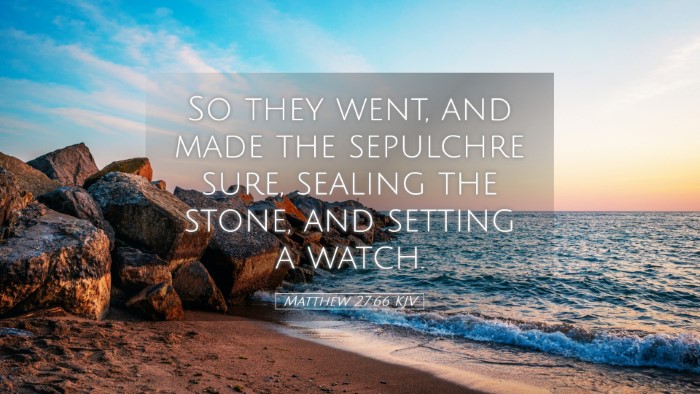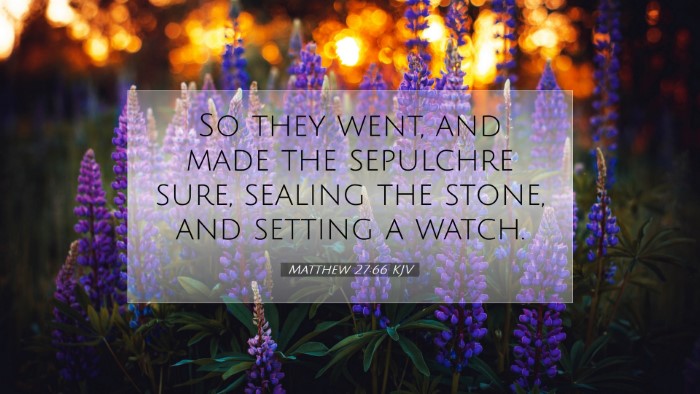Commentary on Matthew 27:66
Verse Context: Matthew 27:66 states, "So they went and made the tomb secure by sealing the stone and setting the guard." This verse falls within the passion narrative and highlights the events following Jesus' crucifixion.
Overview of the Passage
This verse captures a crucial moment after the death of Jesus. The religious leaders, fearful of the potential for Jesus’ followers to steal His body and proclaim a resurrection, take precautions to secure the tomb. The sealing of the stone and the posting of guards reveal their determination and skepticism about Jesus' predictions regarding His resurrection.
Theological Implications
This action demonstrates several theological themes:
- Fear of Accountability: The religious leaders' fear of Jesus’ predictions reflects a broader theme of spiritual blindness and fear of the truth.
- Divine Sovereignty: Though the leaders believed they could prevent the resurrection, their actions ultimately align with God’s redemptive plan, revealing the irony of human attempts to thwart divine purposes.
- Fulfillment of Prophecy: Their efforts to secure the tomb inadvertently validate Jesus’ prophetic declarations about His resurrection.
Insights from Public Domain Commentaries
Matthew Henry
Matthew Henry emphasizes the irony in the religious leaders' actions. They seek to prevent the resurrection of Jesus by taking extensive measures, indicating their lack of faith in the very prophecies they profess to uphold. Henry notes how their attempt to secure the tomb manifests their regret and acknowledgement of Jesus' authority. The guards symbolize both a fear of man and a misunderstanding of God’s power.
Albert Barnes
Barnes provides additional insights into the implications of the guards. He explains that the sealing of the stone was a Roman practice intended to signify the authority of the state in preventing interference. This act not only reflected the leaders' intense desire to counter the claims of the disciples but also foreshadowed the futility of human efforts against divine will. He points out that the guards would later become witnesses to the resurrection, further countering their initial intentions.
Adam Clarke
Clarke elaborates on the security measures taken by the religious leaders, discussing the symbolism of the sealed stone. He notes that the stone serves as an emblem of death, while the seal represents human attempts to control the situation. Clarke asserts that while human measures can secure grave sites, they cannot confine divine action. He emphasizes that the resurrection would prove that no earthly authority can prevent God's purposes from being fulfilled.
Application for Pastors and Theologians
The events surrounding Matthew 27:66 offer critical lessons for contemporary believers:
- Perseverance Despite Opposition: Just as the tomb was sealed in fear, pastors should encourage their congregations not to succumb to doubt or fear in the face of challenges to their faith.
- Understanding God’s Sovereignty: The actions of the religious leaders serve as a reminder of God’s ultimate control over human affairs. It invites believers to trust in God's plan, irrespective of visible circumstances.
- Faithful Witnessing: The guards who were intended to secure the tomb tragically witnessed the resurrection, calling theologians to consider how God can work through unexpected means. This reinforces the call to witness to the truth of the Gospel, regardless of societal pressures.
Conclusion
Matthew 27:66 encapsulates the tension between human attempts to control divine purposes and the exalted plan of God. Through the reflections of prominent commentators, we are reminded of the profound depth of the narrative surrounding Jesus' death and resurrection. It calls believers to recognize that even the most stringent human measures cannot thwart God’s will. As we study this passage, may we be inspired to hold steadfast in our faith, understanding that God’s plans transcend earthly understanding.


